 Facebook
Facebook
 X
X
 Instagram
Instagram
 TikTok
TikTok
 Youtube
Youtube

Pete Wilson grins at a homeless man sprawled near Horton Plaza mall, the downtown shopping center he muscled through city hall in the late 1970s.
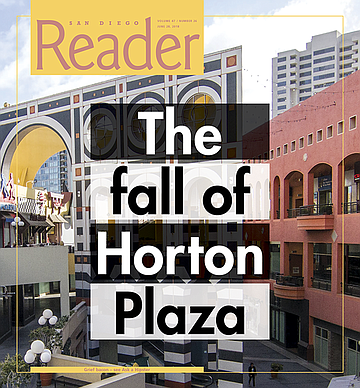
Wilson’s eyes never blink; the coattails of his tailored suit don’t flutter; his cultivated “Aw, shucks,” slightly stooped posture doesn’t change. Like the historic facade of the mall across the street, this Pete Wilson isn’t real.
The still-living Wilson, San Diego’s one-time mayor who rose to become a United States Senator and then governor of California, is now 84, ensconced in the privileged district of Los Angeles that he retreated to after leaving public office in 1998.
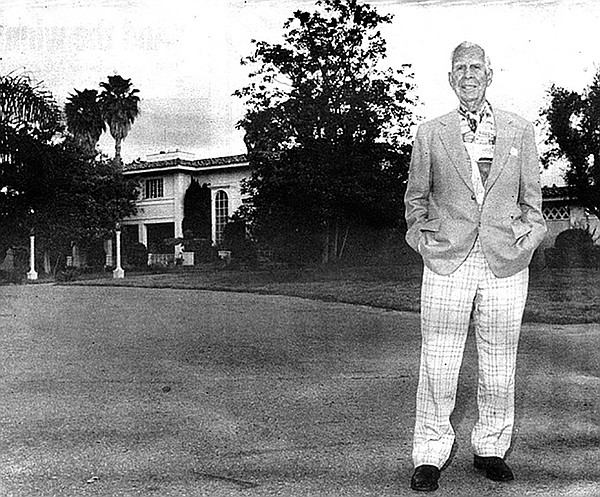
The latest candidate Wilson endorsed for public office, his stepson Phil Graham, an anti-sanctuary Republican running in this June’s primary race for North County’s 76th District Assembly seat, placed third behind two Democrats.
Horton Plaza’s version of Wilson is a life-size bronze statue, erected in 2007 with $200,000 from the ex-mayor’s friends and associates, some enriched by the public money that taxpayers paid for the mall. Lately, though, Pete Wilson’s ghostly monument has been condemned to witness the collapse of the real Pete Wilson’s urban legacy.
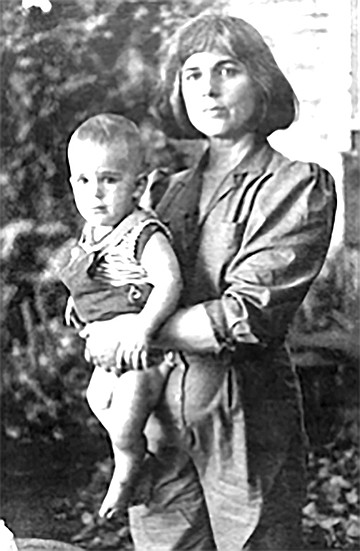
The retail emporium that Wilson argued would save downtown from itself by leveling its historic center and displacing hundreds of homeless denizens with high-spending fashionistas is falling apart.
As ever-growing waves of the homeless sweep across downtown, critics who have followed the byzantine history of the flawed mall are happy to say good riddance to the ex-mayor’s brand of 70s-style social engineering.
But now what?
The future of Horton Plaza is so clouded that Jimbo’s, one of the mall’s newer tenants, has gone to court against the owner Westfield America over millions of dollars in lost sales, alleging that Westfield has virtually abandoned the property.
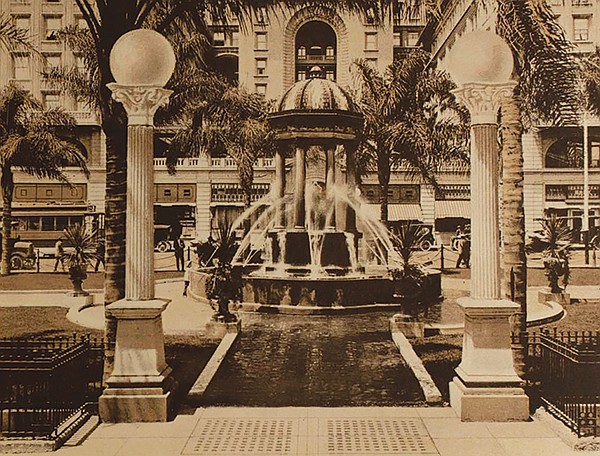
“Westfield’s complete disinterest in maintaining Horton Plaza was appropriately demonstrated when it did not even bother to decorate the mall for the holiday season in 2017,” asserts Jimbo’s, an organic grocery chain.
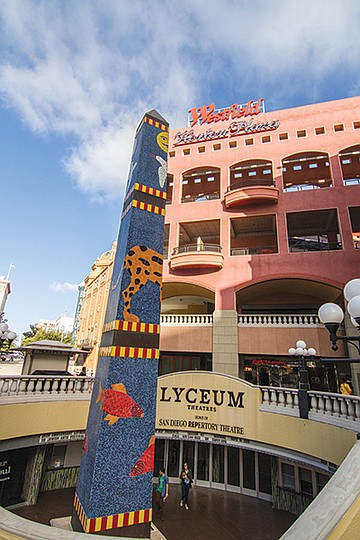
“It’s not any secret that (Westfield is) trying to get out from underneath (Horton Plaza) at this point,” Jimbo’s founder Jim “Jimbo” Someck told the Union-Tribune. “That leaves me in an untenable position.”
The fall of Horton Plaza is made even more painful by the fact that the mall’s costly history may be in danger of repeating itself. As Pete Wilson did four decades ago, an aide to Kevin Faulconer, the present day Republican mayor, has met quietly with at least one wealthy out-of-town developer known for making campaign contributions to secretly map the center’s fate.
An April 30 filing with the city clerk’s office shows that Southwest Strategies, a San Diego influence peddling firm retained by Stockdale Capital Partners of Los Angeles, has lobbied Faulconer’s chief of staff Kris Michell regarding “Horton Plaza land use entitlements related to redevelopment of site.”
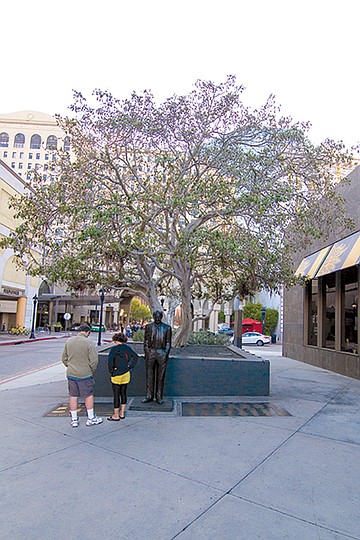
According to Stockdale’s website, the two partners and co-founders of the firm are brothers Steven and Shawn Yari. The Arizona Republic has reported Shawn Yari has fought bitterly with neighbors over his company’s developments in once-sleepy downtown Scottsdale, Arizona.
A March 2012 defamation suit against Bill Crawford, president of the Association to Preserve Downtown Scottsdale’s Quality of Life, was subsequently dismissed.

“Crawford has been a critic of Yari and his developments and is opposing his latest proposal for Scottsdale Retail Plaza, a restaurant, nightclub and retail complex with an indoor-outdoor beach club,” the Republic reported in April 2012. Two weeks ago, word surfaced that Stockdale’s representatives were quietly making the rounds of San Diego business insiders to show off plans to convert the mall into an example of the latest developer fad, a multi-story office park, ostensibly appealing to Millennials with a collection of high-tech work spaces, gourmet eateries, and fitness boutiques.
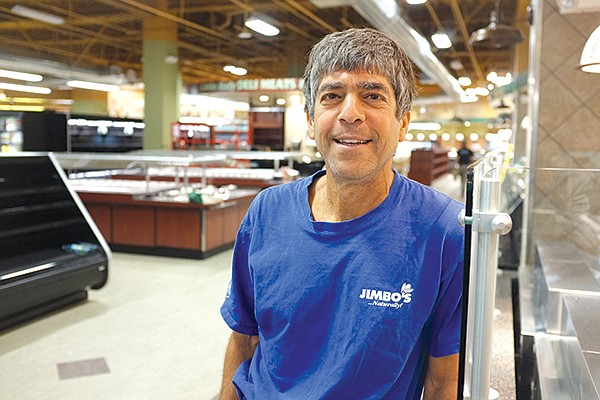
How much money taxpayers would end up paying to subsidize the scheme, or whether there are better things that could be done with the center of downtown, are questions remaining to be answered.
Two years ago, Faulconer held secret discussions with Horton Plaza owner Westfield America about redeveloping the property, documents released by the city after a request under the state’s public records act show.
“On behalf of our client Westfield, we are requesting a meeting between Mayor Faulconer and Bill Hecht, the Chief Operating Officer of Westfield America,” lobbyist Chris Wahl emailed the mayor’s office on June 3, 2016.
“The purpose of this meeting would be to provide the Mayor with an update on: 1.) Major tenant plans at Horton Plaza 2.) Development plans for Horton Plaza and Mission Valley 3). Opportunities to streamline permit requirements at [University Town Center].” No other information has been released, and the mayor’s office has gone dark on the matter as levels of stores have abandoned the mall.
Malls across America are dying, as the bricks-and-mortar retail business succumbs to the rise of the Internet. But Horton Plaza’s failure is a special case of urban planning gone awry, beset by blatant conflicts of interest and secretive financial and political agendas that allowed competing malls Fashion Valley, University Towne Center, and even North County Fair in Escondido to flourish as downtown struggled with a tide of unrelieved homelessness worsened by the shopping center’s development.
A child of born of political convenience between Wilson and Ernie Hahn, who built San Diego’s Fashion Valley mall in 1969 with the notorious financier and Richard Nixon-backer C. Arnholt Smith, Horton Plaza became a pawn in Hahn’s great game of expanding his shopping center empire by expanding Fashion Valley and building Escondido’s North County Fair.
Wilson wanted to be governor of California, giving Hahn an opportunity to ply the young mayor with campaign cash and years of public relations assistance in exchange for development permits.
Hahn first promised to build Horton Plaza in 1974, but that turned out to only the beginning of an eight-year-long stall. “At the time he signed the Horton Plaza development agreement, Mr. Hahn specified that a ‘laundry list’ of downtown improvements had to be made before he would proceed,” the Baltimore Sun observed when the mall finally opened in August 1985.
“Those improvements, which included the 20-mile San Diego Trolley to the Mexican border, the establishment of a semi-autonomous Centre City Development Corporation and the designation of a housing redevelopment area south of the center, took years to materialize. Some of the items, including the convention center, are not yet finished.”
The developer also blamed the downtown homeless. Apocryphal or not, accounts multiplied of Hahn complaining how hard it was to get department store tenants to locate in a downtown where “bums peed in their shoes.” Hahn made the answer clear: bulldoze their living quarters.
Meanwhile, the developer was allowed by Wilson to extend his empire to the north, as the San Diego mayor cleared the way for the developer’s suburban desires - as in the case of Escondido endorsing a deal to sell off acreage owned by the city of San Diego’s water department.
“Should 75 acres of Kit Carson Park, located in the southern part of Escondido, be leased as a shopping center site and, to replace that land, 77 acres of property adjoining the park be purchased from the city of San Diego?” was the question facing Escondido voters in a June 1979 plebiscite won by Hahn with a 56 percent majority, the Los Angeles Times reported.
Though some in Escondido quibbled over the $1.3 million price their city had to pay San Diego, the deal turned out to be a veritable bargain, costing just $16,775 an acre, the Times noted.
As further sweetener, Hahn’s victory meant that a competing mall he once had planned for Penasquitos, to be built without taxpayer subsidy within the city limits of San Diego, would not be built, allowing the city of Escondido to collect millions of dollars in annual sales taxes at the expense of its municipal neighbor to the south.
Even as progress on Horton Plaza continued to fall behind, the developer pushed ahead with a Wilson-blessed expansion of Fashion Valley in the bed of the flood-prone San Diego River, opening three new department stores, parking garages, and a new level of specialty shops in 1981.
“At Fashion Valley, Neiman-Marcus and Nordstrom, both of which opened in the fall, say their sales are ahead of projections,” reported L.A. Times business writer and future city councilwoman Barbara Bry in December 1981.
Horton Plaza, the mall that was supposed to spawn a downtown revival, became a costly laggard, surviving only by the grace of Wilson’s political ambitions and his ability to spend public money and expedite permits as Hahn consolidated his northern holdings.
Finally, in the summer of 1979, with Escondido voters having safely approved the North County Fair land deal with San Diego that June, Hahn pronounced himself ready to proceed with Horton Plaza and unveiled plans to scrape away blocks of old buildings, many housing low-income residents.
Although construction of the mall wouldn’t begin until three years later as Hahn sparred with the city over financial terms, Wilson sat beaming in his seat atop the city council dais. Besides rousting legions of panhandlers, the mayor could also claim to have destroyed the early 20th Century playhouse occupied by the Pussycat Theatre, a pornographic movie palace.
The lurid enterprise was owned by reputed Hollywood mobster Vince Miranda, whose presence Wilson used to bait critics who questioned the mall’s high cost to taxpayers and its design, walled off on two sides from the surrounding neighborhood by parking structures.
“Rejecting the pleas of theater activists and porno figure Vincent Miranda, the San Diego City Council voted Wednesday to allow construction of a $132 million downtown shopping center where the historic Lyceum Theater and Horton Grand Hotel now stand,” wrote Los Angeles Times reporter Richard Paddock in August 1979.
“On a 5-2 vote, the council approved agreements with shopping center magnate Ernest W. Hahn to build the six-block Horton Plaza Retail Center. Construction of the shopping center adjacent to Horton Plaza will mean relocation of 49 businesses and 253 families and individuals, as well as demolition of the Lyceum Theater and Horton Grand Hotel.”
“This is a great day in the city’s history,” Wilson proclaimed before casting his vote for the mall he would repeatedly cite as proof of his city-building prowess when he ran for governor, the United States Senate, and the presidency. “It would be a tragic mistake to miss this opportunity.”
Decades later, architect and California historic preservation chief Wayne Donaldson suggested the failed mall itself was the tragedy in a March 1992 interview with the Los Angeles Times.
“We lost six buildings that were on the National Register’ of Historic Places,” Donaldson said. “I don’t think that would be allowed to happen today.”
“Looking back,” the Times added, “he regrets the demolition of such historic downtown buildings as the Cabrillo and Plaza theaters to make way for the Horton Plaza shopping center.”
“He also regrets that Horton Plaza is closed off along 4th Avenue, contributing little in the way of foot traffic to the struggling Gaslamp.”
To abet the blanket demolition, Hahn retained the services of Los Angeles architect Jon Jerde, a glib self-promoter who promised to create an unprecedented “festival marketplace” to replace the historic neighborhood to be demolished.
The Knights of Pythias building was to meet the wrecking ball and be replaced with a stucco version, a la Disneyland’s Main Street. A block away, a classical bank building was also to be recast in stucco and welded onto the side of the garish facade of Robinson’s department store.
Locals outside the city’s business establishment scratched their heads, but Jerde’s public relations blitz worked wonders on many East Coast journalists and critics who parachuted into the city to author starry-eyed takes on the redevelopment project
“Rather than an enclosed mall, it is a kind of urban village placed in the heart of the city, with a multilevel, open-air system of twisting streets and walks set in an extraordinary architectural framework,” gushed New York Times West Coast correspondent Robert Lindsey on August 17, 1985, a week after the shopping center opened.
“It is not a shopping center, another complex of buildings,’’ said Jerde, who died in 2015. “It is a new zone of the city, an extension of the city’s streets and a pilot light for the eventual complete rebirth of downtown.’’
A story carried by the Knight Ridder News Service added, “The concentration of stores and activity is designed to evoke a European street scene, Mr. Hahn says, to make Horton Plaza a destination point, an irresistible beehive of culture and commerce.”
When coverage by the San Diego Union’s theatre critic Welton Jones pressed Wilson over the demolition of the Lyceum Theatre, suggesting the historic venue should have been restored instead of leveled, Hahn and Wilson worked out a deal in which the developer hollowed out a 20,000-square-foot concrete shell buried under the mall for a two-theatre complex, also called the Lyceum, to be funded by taxpayers.
“With the Lyceum Theatre at 314 F St. facing a date with the wrecking ball, many city officials and community activists have expressed concern that downtown might be left without a mid-size theater comparable to the Lyceum, a 420-seat facility listed on the National Historic Register,” the Times reported February 24, 1982.
“The city might have to issue as much as $6.4 million in bonds to produce the $3.9 million needed for the new theater,” the paper added that April in a story that featured the center’s growing costs.
Ground for Horton Plaza was finally broken in October 1982, only a month before Pete Wilson beat Democratic ex-Governor Jerry Brown for the Senate and left for Washington. The ex-mayor staged a triumphant homecoming to San Diego for the grand opening party on August 8, 1985.
The next day, an estimated 70,000 people showed up for the official opening ceremonies, which included a beaming Wilson and Hahn together in what the L.A. Times called a “garland-cutting.”
Real estate speculators with friends at city hall also had reason to be happy. Under Wilson’s sway, city law and ethics officials were reluctant to question the rationale for the project’s enormous subsidies or investigate the involvement of the mayor’s contributors and cronies in nearby development.
In one publicized 1982 case, John Davies — Wilson’s roommate in law school who later mentored the mayor regarding San Diego’s brand of big money politics and campaign fundraising — had a financial interest in the Grant Hotel directly across the street from the future shopping center.
Wilson had appointed Davies to the city planning commission, where as chairman the wealthy lawyer repeatedly led votes to approve the mall over the objections of historic preservationists and other critics seeking to change the project’s pedestrian-unfriendly exterior and other design problems which critics now say ultimately doomed it to failure.
“I thought maybe it died,” assistant city attorney Robert Teaze told the Los Angeles Times in September 1982 when a reporter asked him why a conflict-of-interest complaint about Davies lodged the previous April by Democrat Mel Shapiro and onetime mayoral candidate Si Casady had gone ignored for months.
“Just as soon it died.” Teaze explained. “I wasn’t sitting on it. I had other things to do and I hoped it would go away.” Shortly after the query by the Times, he produced an opinion exonerating the mayor’s best friend.
“In and of itself, the determination of the Planning Commission did not have a ‘material financial effect’ on the market value of surrounding land,” contended Teaze, who died in 2014.
“That conclusion is much different from the city’s action in the 1977 Morrow case,” noted the Times, which described a 1970s ethics complaint brought by Republican city attorney John Witt against Democratic city councilman Floyd Morrow.
“In that case Morrow voted on plans for a redevelopment shopping center in Linda Vista located across the street from land owned by a nonprofit corporation in which he was president and counsel.
“Charging that Morrow had a conflict of interest in the matter, Witt prosecuted the councilman and won, a decision which was later affirmed by the state Court of Appeal. The ruling prohibited Morrow from voting again on the project.”
Davies, who died in 2011, downplayed the matter, telling the Times, “It never occurred to me that there was anything the Grant would be interested in one way or another.”
Added the Times, “Davies said he receives no income for serving as secretary of CDS-Grant, which is headed by his friend and business partner in other enterprises, Christopher D. Sickels.”
Hahn did not live much longer to enjoy his triumph, dying at his Rancho Santa Fe estate on December 28, 1992 of prostate cancer at 73. Though remaining as chairman, he had sold his company to Canadian real estate giant Trizec Corporation Ltd. in November 1980 for $267 million, and his role faded with time. He was safely retired when neighborhoods near Horton Plaza began to complain about side effects wrought by the mall.
“When Horton Plaza opened, the public drunks from the central area were pushed into our area,” Juliette Mondot, who with her husband was raising a family in what is now called East Village, told the Reader in August 1989.
“I call it economic feudalism,” Mondot complained. “They have turned a residential area into a de facto refugee camp.”
Added the story, “Around the corner, in front of a rescue mission that was relocated from the Gaslamp Quarter at part of a city-financed effort to revitalize that area, an even greater number of transients congregate on the sidewalks, and in the street, to encourage them not to defecate on the street, the city has installed porta-potties.”


Pete Wilson grins at a homeless man sprawled near Horton Plaza mall, the downtown shopping center he muscled through city hall in the late 1970s.

Wilson’s eyes never blink; the coattails of his tailored suit don’t flutter; his cultivated “Aw, shucks,” slightly stooped posture doesn’t change. Like the historic facade of the mall across the street, this Pete Wilson isn’t real.
The still-living Wilson, San Diego’s one-time mayor who rose to become a United States Senator and then governor of California, is now 84, ensconced in the privileged district of Los Angeles that he retreated to after leaving public office in 1998.

The latest candidate Wilson endorsed for public office, his stepson Phil Graham, an anti-sanctuary Republican running in this June’s primary race for North County’s 76th District Assembly seat, placed third behind two Democrats.
Horton Plaza’s version of Wilson is a life-size bronze statue, erected in 2007 with $200,000 from the ex-mayor’s friends and associates, some enriched by the public money that taxpayers paid for the mall. Lately, though, Pete Wilson’s ghostly monument has been condemned to witness the collapse of the real Pete Wilson’s urban legacy.

The retail emporium that Wilson argued would save downtown from itself by leveling its historic center and displacing hundreds of homeless denizens with high-spending fashionistas is falling apart.
As ever-growing waves of the homeless sweep across downtown, critics who have followed the byzantine history of the flawed mall are happy to say good riddance to the ex-mayor’s brand of 70s-style social engineering.
But now what?
The future of Horton Plaza is so clouded that Jimbo’s, one of the mall’s newer tenants, has gone to court against the owner Westfield America over millions of dollars in lost sales, alleging that Westfield has virtually abandoned the property.

“Westfield’s complete disinterest in maintaining Horton Plaza was appropriately demonstrated when it did not even bother to decorate the mall for the holiday season in 2017,” asserts Jimbo’s, an organic grocery chain.

“It’s not any secret that (Westfield is) trying to get out from underneath (Horton Plaza) at this point,” Jimbo’s founder Jim “Jimbo” Someck told the Union-Tribune. “That leaves me in an untenable position.”
The fall of Horton Plaza is made even more painful by the fact that the mall’s costly history may be in danger of repeating itself. As Pete Wilson did four decades ago, an aide to Kevin Faulconer, the present day Republican mayor, has met quietly with at least one wealthy out-of-town developer known for making campaign contributions to secretly map the center’s fate.
An April 30 filing with the city clerk’s office shows that Southwest Strategies, a San Diego influence peddling firm retained by Stockdale Capital Partners of Los Angeles, has lobbied Faulconer’s chief of staff Kris Michell regarding “Horton Plaza land use entitlements related to redevelopment of site.”

According to Stockdale’s website, the two partners and co-founders of the firm are brothers Steven and Shawn Yari. The Arizona Republic has reported Shawn Yari has fought bitterly with neighbors over his company’s developments in once-sleepy downtown Scottsdale, Arizona.
A March 2012 defamation suit against Bill Crawford, president of the Association to Preserve Downtown Scottsdale’s Quality of Life, was subsequently dismissed.

“Crawford has been a critic of Yari and his developments and is opposing his latest proposal for Scottsdale Retail Plaza, a restaurant, nightclub and retail complex with an indoor-outdoor beach club,” the Republic reported in April 2012. Two weeks ago, word surfaced that Stockdale’s representatives were quietly making the rounds of San Diego business insiders to show off plans to convert the mall into an example of the latest developer fad, a multi-story office park, ostensibly appealing to Millennials with a collection of high-tech work spaces, gourmet eateries, and fitness boutiques.

How much money taxpayers would end up paying to subsidize the scheme, or whether there are better things that could be done with the center of downtown, are questions remaining to be answered.
Two years ago, Faulconer held secret discussions with Horton Plaza owner Westfield America about redeveloping the property, documents released by the city after a request under the state’s public records act show.
“On behalf of our client Westfield, we are requesting a meeting between Mayor Faulconer and Bill Hecht, the Chief Operating Officer of Westfield America,” lobbyist Chris Wahl emailed the mayor’s office on June 3, 2016.
“The purpose of this meeting would be to provide the Mayor with an update on: 1.) Major tenant plans at Horton Plaza 2.) Development plans for Horton Plaza and Mission Valley 3). Opportunities to streamline permit requirements at [University Town Center].” No other information has been released, and the mayor’s office has gone dark on the matter as levels of stores have abandoned the mall.
Malls across America are dying, as the bricks-and-mortar retail business succumbs to the rise of the Internet. But Horton Plaza’s failure is a special case of urban planning gone awry, beset by blatant conflicts of interest and secretive financial and political agendas that allowed competing malls Fashion Valley, University Towne Center, and even North County Fair in Escondido to flourish as downtown struggled with a tide of unrelieved homelessness worsened by the shopping center’s development.
A child of born of political convenience between Wilson and Ernie Hahn, who built San Diego’s Fashion Valley mall in 1969 with the notorious financier and Richard Nixon-backer C. Arnholt Smith, Horton Plaza became a pawn in Hahn’s great game of expanding his shopping center empire by expanding Fashion Valley and building Escondido’s North County Fair.
Wilson wanted to be governor of California, giving Hahn an opportunity to ply the young mayor with campaign cash and years of public relations assistance in exchange for development permits.
Hahn first promised to build Horton Plaza in 1974, but that turned out to only the beginning of an eight-year-long stall. “At the time he signed the Horton Plaza development agreement, Mr. Hahn specified that a ‘laundry list’ of downtown improvements had to be made before he would proceed,” the Baltimore Sun observed when the mall finally opened in August 1985.
“Those improvements, which included the 20-mile San Diego Trolley to the Mexican border, the establishment of a semi-autonomous Centre City Development Corporation and the designation of a housing redevelopment area south of the center, took years to materialize. Some of the items, including the convention center, are not yet finished.”
The developer also blamed the downtown homeless. Apocryphal or not, accounts multiplied of Hahn complaining how hard it was to get department store tenants to locate in a downtown where “bums peed in their shoes.” Hahn made the answer clear: bulldoze their living quarters.
Meanwhile, the developer was allowed by Wilson to extend his empire to the north, as the San Diego mayor cleared the way for the developer’s suburban desires - as in the case of Escondido endorsing a deal to sell off acreage owned by the city of San Diego’s water department.
“Should 75 acres of Kit Carson Park, located in the southern part of Escondido, be leased as a shopping center site and, to replace that land, 77 acres of property adjoining the park be purchased from the city of San Diego?” was the question facing Escondido voters in a June 1979 plebiscite won by Hahn with a 56 percent majority, the Los Angeles Times reported.
Though some in Escondido quibbled over the $1.3 million price their city had to pay San Diego, the deal turned out to be a veritable bargain, costing just $16,775 an acre, the Times noted.
As further sweetener, Hahn’s victory meant that a competing mall he once had planned for Penasquitos, to be built without taxpayer subsidy within the city limits of San Diego, would not be built, allowing the city of Escondido to collect millions of dollars in annual sales taxes at the expense of its municipal neighbor to the south.
Even as progress on Horton Plaza continued to fall behind, the developer pushed ahead with a Wilson-blessed expansion of Fashion Valley in the bed of the flood-prone San Diego River, opening three new department stores, parking garages, and a new level of specialty shops in 1981.
“At Fashion Valley, Neiman-Marcus and Nordstrom, both of which opened in the fall, say their sales are ahead of projections,” reported L.A. Times business writer and future city councilwoman Barbara Bry in December 1981.
Horton Plaza, the mall that was supposed to spawn a downtown revival, became a costly laggard, surviving only by the grace of Wilson’s political ambitions and his ability to spend public money and expedite permits as Hahn consolidated his northern holdings.
Finally, in the summer of 1979, with Escondido voters having safely approved the North County Fair land deal with San Diego that June, Hahn pronounced himself ready to proceed with Horton Plaza and unveiled plans to scrape away blocks of old buildings, many housing low-income residents.
Although construction of the mall wouldn’t begin until three years later as Hahn sparred with the city over financial terms, Wilson sat beaming in his seat atop the city council dais. Besides rousting legions of panhandlers, the mayor could also claim to have destroyed the early 20th Century playhouse occupied by the Pussycat Theatre, a pornographic movie palace.
The lurid enterprise was owned by reputed Hollywood mobster Vince Miranda, whose presence Wilson used to bait critics who questioned the mall’s high cost to taxpayers and its design, walled off on two sides from the surrounding neighborhood by parking structures.
“Rejecting the pleas of theater activists and porno figure Vincent Miranda, the San Diego City Council voted Wednesday to allow construction of a $132 million downtown shopping center where the historic Lyceum Theater and Horton Grand Hotel now stand,” wrote Los Angeles Times reporter Richard Paddock in August 1979.
“On a 5-2 vote, the council approved agreements with shopping center magnate Ernest W. Hahn to build the six-block Horton Plaza Retail Center. Construction of the shopping center adjacent to Horton Plaza will mean relocation of 49 businesses and 253 families and individuals, as well as demolition of the Lyceum Theater and Horton Grand Hotel.”
“This is a great day in the city’s history,” Wilson proclaimed before casting his vote for the mall he would repeatedly cite as proof of his city-building prowess when he ran for governor, the United States Senate, and the presidency. “It would be a tragic mistake to miss this opportunity.”
Decades later, architect and California historic preservation chief Wayne Donaldson suggested the failed mall itself was the tragedy in a March 1992 interview with the Los Angeles Times.
“We lost six buildings that were on the National Register’ of Historic Places,” Donaldson said. “I don’t think that would be allowed to happen today.”
“Looking back,” the Times added, “he regrets the demolition of such historic downtown buildings as the Cabrillo and Plaza theaters to make way for the Horton Plaza shopping center.”
“He also regrets that Horton Plaza is closed off along 4th Avenue, contributing little in the way of foot traffic to the struggling Gaslamp.”
To abet the blanket demolition, Hahn retained the services of Los Angeles architect Jon Jerde, a glib self-promoter who promised to create an unprecedented “festival marketplace” to replace the historic neighborhood to be demolished.
The Knights of Pythias building was to meet the wrecking ball and be replaced with a stucco version, a la Disneyland’s Main Street. A block away, a classical bank building was also to be recast in stucco and welded onto the side of the garish facade of Robinson’s department store.
Locals outside the city’s business establishment scratched their heads, but Jerde’s public relations blitz worked wonders on many East Coast journalists and critics who parachuted into the city to author starry-eyed takes on the redevelopment project
“Rather than an enclosed mall, it is a kind of urban village placed in the heart of the city, with a multilevel, open-air system of twisting streets and walks set in an extraordinary architectural framework,” gushed New York Times West Coast correspondent Robert Lindsey on August 17, 1985, a week after the shopping center opened.
“It is not a shopping center, another complex of buildings,’’ said Jerde, who died in 2015. “It is a new zone of the city, an extension of the city’s streets and a pilot light for the eventual complete rebirth of downtown.’’
A story carried by the Knight Ridder News Service added, “The concentration of stores and activity is designed to evoke a European street scene, Mr. Hahn says, to make Horton Plaza a destination point, an irresistible beehive of culture and commerce.”
When coverage by the San Diego Union’s theatre critic Welton Jones pressed Wilson over the demolition of the Lyceum Theatre, suggesting the historic venue should have been restored instead of leveled, Hahn and Wilson worked out a deal in which the developer hollowed out a 20,000-square-foot concrete shell buried under the mall for a two-theatre complex, also called the Lyceum, to be funded by taxpayers.
“With the Lyceum Theatre at 314 F St. facing a date with the wrecking ball, many city officials and community activists have expressed concern that downtown might be left without a mid-size theater comparable to the Lyceum, a 420-seat facility listed on the National Historic Register,” the Times reported February 24, 1982.
“The city might have to issue as much as $6.4 million in bonds to produce the $3.9 million needed for the new theater,” the paper added that April in a story that featured the center’s growing costs.
Ground for Horton Plaza was finally broken in October 1982, only a month before Pete Wilson beat Democratic ex-Governor Jerry Brown for the Senate and left for Washington. The ex-mayor staged a triumphant homecoming to San Diego for the grand opening party on August 8, 1985.
The next day, an estimated 70,000 people showed up for the official opening ceremonies, which included a beaming Wilson and Hahn together in what the L.A. Times called a “garland-cutting.”
Real estate speculators with friends at city hall also had reason to be happy. Under Wilson’s sway, city law and ethics officials were reluctant to question the rationale for the project’s enormous subsidies or investigate the involvement of the mayor’s contributors and cronies in nearby development.
In one publicized 1982 case, John Davies — Wilson’s roommate in law school who later mentored the mayor regarding San Diego’s brand of big money politics and campaign fundraising — had a financial interest in the Grant Hotel directly across the street from the future shopping center.
Wilson had appointed Davies to the city planning commission, where as chairman the wealthy lawyer repeatedly led votes to approve the mall over the objections of historic preservationists and other critics seeking to change the project’s pedestrian-unfriendly exterior and other design problems which critics now say ultimately doomed it to failure.
“I thought maybe it died,” assistant city attorney Robert Teaze told the Los Angeles Times in September 1982 when a reporter asked him why a conflict-of-interest complaint about Davies lodged the previous April by Democrat Mel Shapiro and onetime mayoral candidate Si Casady had gone ignored for months.
“Just as soon it died.” Teaze explained. “I wasn’t sitting on it. I had other things to do and I hoped it would go away.” Shortly after the query by the Times, he produced an opinion exonerating the mayor’s best friend.
“In and of itself, the determination of the Planning Commission did not have a ‘material financial effect’ on the market value of surrounding land,” contended Teaze, who died in 2014.
“That conclusion is much different from the city’s action in the 1977 Morrow case,” noted the Times, which described a 1970s ethics complaint brought by Republican city attorney John Witt against Democratic city councilman Floyd Morrow.
“In that case Morrow voted on plans for a redevelopment shopping center in Linda Vista located across the street from land owned by a nonprofit corporation in which he was president and counsel.
“Charging that Morrow had a conflict of interest in the matter, Witt prosecuted the councilman and won, a decision which was later affirmed by the state Court of Appeal. The ruling prohibited Morrow from voting again on the project.”
Davies, who died in 2011, downplayed the matter, telling the Times, “It never occurred to me that there was anything the Grant would be interested in one way or another.”
Added the Times, “Davies said he receives no income for serving as secretary of CDS-Grant, which is headed by his friend and business partner in other enterprises, Christopher D. Sickels.”
Hahn did not live much longer to enjoy his triumph, dying at his Rancho Santa Fe estate on December 28, 1992 of prostate cancer at 73. Though remaining as chairman, he had sold his company to Canadian real estate giant Trizec Corporation Ltd. in November 1980 for $267 million, and his role faded with time. He was safely retired when neighborhoods near Horton Plaza began to complain about side effects wrought by the mall.
“When Horton Plaza opened, the public drunks from the central area were pushed into our area,” Juliette Mondot, who with her husband was raising a family in what is now called East Village, told the Reader in August 1989.
“I call it economic feudalism,” Mondot complained. “They have turned a residential area into a de facto refugee camp.”
Added the story, “Around the corner, in front of a rescue mission that was relocated from the Gaslamp Quarter at part of a city-financed effort to revitalize that area, an even greater number of transients congregate on the sidewalks, and in the street, to encourage them not to defecate on the street, the city has installed porta-potties.”
Comments